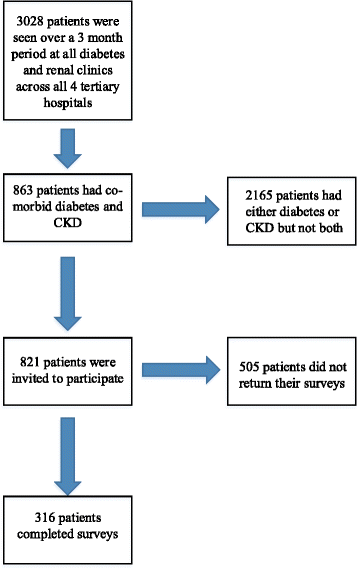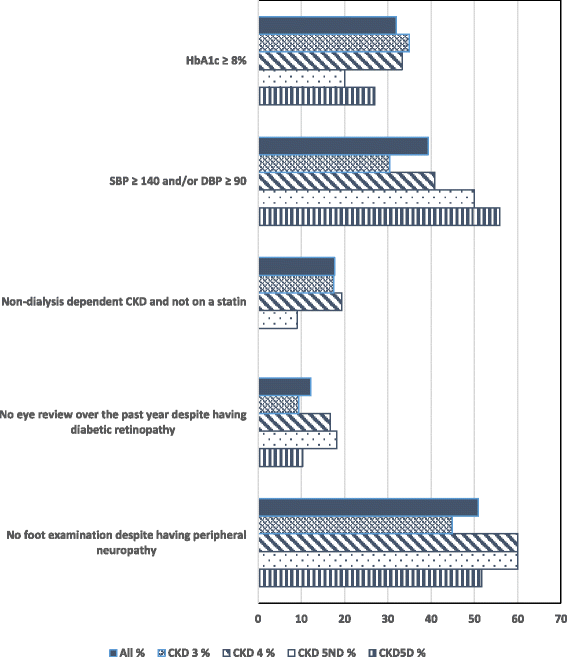Gaps and barriers in health-care provision for co-morbid diabetes and chronic kidney disease: a cross-sectional study
- PMID: 28245800
- PMCID: PMC5331625
- DOI: 10.1186/s12882-017-0493-x
Gaps and barriers in health-care provision for co-morbid diabetes and chronic kidney disease: a cross-sectional study
Abstract
Background: Patients with diabetes and chronic kidney disease (CKD) are a complex subset of the growing number of patients with diabetes, due to multi-morbidity. Gaps between recommended and received care for diabetes and chronic kidney disease (CKD) are evident despite promulgation of guidelines. Here, we document gaps in tertiary health-care, and the commonest patient-reported barriers to health-care, before exploring the association between these gaps and barriers.
Methods: This cross-sectional study recruited patients with diabetes and CKD (eGFR < 60 mL/min/1.73 m2) across 4 large hospitals. For each patient, questionnaires were completed examining clinical data, recommended care, and patient-reported barriers limiting health-care. Descriptive statistics, subgroup analyses by CKD stage and hospital, and analyses examining the relationship between health-care gaps and barriers were performed.
Results: 308 patients, of mean age 66.9 (SD 11.0) years, and mostly male (69.5%) and having type 2 diabetes (88.0%), participated. 49.1% had stage 3, 24.7% stage 4 and 26.3% stage 5 CKD. Gaps between recommended versus received care were evident: 31.9% of patients had an HbA1c ≥ 8%, and 39.3% had a measured blood pressure ≥ 140/90 mmHg. The commonest barriers were poor continuity of care (49.3%), inadequate understanding/education about CKD (43.5%), and feeling unwell (42.6%). However, barriers associated with a failure to receive items of recommended care were inadequate support from family and friends, conflicting advice from and poor communication amongst specialists, the effect of co-morbidities on self-management and feeling unmotivated (all p < 0.05).
Conclusions: Barriers to health-care varied across CKD stages and hospitals. Barriers associated with a deviation from recommended care were different for different items of care, suggesting that specific interventions targeting each item of care are required.
Keywords: Barriers; Chronic kidney disease; Diabetes; Health-care; Multi-morbidity; Tertiary health-care; Treatment gaps.
Figures



Similar articles
-
Patient-reported barriers and outcomes associated with poor glycaemic and blood pressure control in co-morbid diabetes and chronic kidney disease.J Diabetes Complications. 2019 Jan;33(1):63-68. doi: 10.1016/j.jdiacomp.2018.09.020. Epub 2018 Oct 12. J Diabetes Complications. 2019. PMID: 30621853
-
A need-based approach to self-management education for adults with co-morbid diabetes and chronic kidney disease.BMC Nephrol. 2019 Apr 2;20(1):113. doi: 10.1186/s12882-019-1296-z. BMC Nephrol. 2019. PMID: 30940170 Free PMC article.
-
The Perspectives of Patients on Health-Care for Co-Morbid Diabetes and Chronic Kidney Disease: A Qualitative Study.PLoS One. 2016 Jan 5;11(1):e0146615. doi: 10.1371/journal.pone.0146615. eCollection 2016. PLoS One. 2016. PMID: 26730708 Free PMC article.
-
Models of care for co-morbid diabetes and chronic kidney disease.Nephrology (Carlton). 2018 Aug;23(8):711-717. doi: 10.1111/nep.13232. Nephrology (Carlton). 2018. PMID: 29405503 Review.
-
Barriers and enablers to detection and management of chronic kidney disease in primary healthcare: a systematic review.BMC Nephrol. 2020 Mar 12;21(1):83. doi: 10.1186/s12882-020-01731-x. BMC Nephrol. 2020. PMID: 32160886 Free PMC article.
Cited by
-
Effect of a Web-Based Management Guide on Risk Factors in Patients With Type 2 Diabetes and Diabetic Kidney Disease: A JADE Randomized Clinical Trial.JAMA Netw Open. 2022 Mar 1;5(3):e223862. doi: 10.1001/jamanetworkopen.2022.3862. JAMA Netw Open. 2022. PMID: 35333363 Free PMC article. Clinical Trial.
-
Providing diabetes education to patients with chronic kidney disease: A survey of diabetes educators in Ontario, Canada.J Multimorb Comorb. 2021 Dec 13;11:26335565211062758. doi: 10.1177/26335565211062758. eCollection 2021 Jan-Dec. J Multimorb Comorb. 2021. PMID: 34926313 Free PMC article.
-
Diabetes Management and Outcomes among Patients with Type 2 Diabetes Attending a Renal Service.J Diabetes Res. 2023 Apr 26;2023:1969145. doi: 10.1155/2023/1969145. eCollection 2023. J Diabetes Res. 2023. PMID: 37152098 Free PMC article.
-
The Impact of a Social Networking Service-Enhanced Smart Care Model on Stage 5 Chronic Kidney Disease: Quasi-Experimental Study.J Med Internet Res. 2020 Apr 14;22(4):e15565. doi: 10.2196/15565. J Med Internet Res. 2020. PMID: 32200348 Free PMC article.
-
Guidelines, policies, and barriers to kidney care: findings from a global survey.Kidney Int Suppl (2011). 2018 Feb;8(2):30-40. doi: 10.1016/j.kisu.2017.10.007. Epub 2018 Jan 19. Kidney Int Suppl (2011). 2018. PMID: 30675437 Free PMC article. Review.
References
-
- IDF. IDF Diabetes Atlas 6th Edition. 2013.
-
- Atun R. Transitioning health systems for multimorbidity. Lancet. 2015. doi:10.1016/s0140-6736(14)62254-6. - PubMed
MeSH terms
LinkOut - more resources
Full Text Sources
Other Literature Sources
Medical
Research Materials
Miscellaneous

